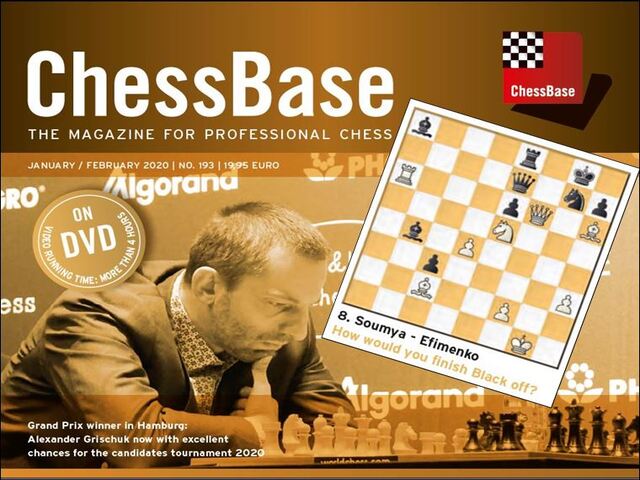A review of CBM 193
There is no secret road to chess improvement. Even the magical word "talent" will not conjure 100 rating points in this new year. But there is the very real effect of effort and time. And there is one chess product, made by top chess professionals, which comes to our proverbial doors (in minutes thanks to fast internet downloads!) every other month. Taking advantage of such a bounty is the smart thing to do. In 2019, I gained over 100 points, and kept them — a stable 1950+ rating, thanks to regular use of ChessBase products.
And what about time? One of my students asked me: when will I improve in chess? And I didn't know what to tell her, because nowadays everyone is easily offended if confronted with the simple truth that one cannot improve without putting in the time. Yes, 1-2 hours a day are needed to improve, yet many people think that just going on different chess sites will make them stronger.

But I have a coach! Well, that's all well and good, but unfortunately many of us don't have the money to invest in grandmaster training for 1-2 or more hours a week, hoping the GM then give us homework. I also don't have that kind of money (though I do believe its merit, based on reading biographies and interviews of most champions) so I have to use alternative means to improve in chess, the one I found working well is — you guessed it — Chessbase Magazine (from now on shortened to CBM).
Last year I began following GM Karsten Mueller seriously, through his books and his column in CBM. I believe this was one of the main ingredients which helped me improve. Why? Well, Pal Benko once complained that he and Sammy Reshevsky would study openings all day long, and by evening it was like Reshevsky didn't study a thing! Like someone had hit Reshevsky's reset button! For me, in the opening (my own version of Reshevsky's faulty memory) and in the middlegame I make bad evaluations and calculation mistakes, but when I reach the endgame, thanks to what I learned in CBM and some of Mueller's books, I'm able to save lost positions.
 I began reading CBM 193 with "rook endings" — the latest column by Mueller. It's no mystery that rook endings occur very often, and they are definitely a must for those who seek real chess improvement. In fact, if I remember well, GM Alex Yermolinsky in a podcast interview mentioned he made a giant leap in chess understanding when he practiced the rook endgames from a small little booklet: Practical Guide to Rook Endgames by Minev.
I began reading CBM 193 with "rook endings" — the latest column by Mueller. It's no mystery that rook endings occur very often, and they are definitely a must for those who seek real chess improvement. In fact, if I remember well, GM Alex Yermolinsky in a podcast interview mentioned he made a giant leap in chess understanding when he practiced the rook endgames from a small little booklet: Practical Guide to Rook Endgames by Minev.
(By the way, while looking for a cover image of the above mentioned book, I discovered it's sold for between USD $200-900. In case someone is interested I'm selling my copy for half that price! Why? Because Karsten Mueller's column in CBM is all I need to improve!)
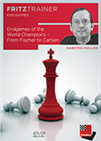 Let endgame expert Dr Karsten Müller show and explain the finesses of the world champions. Although they had different styles each and every one of them played the endgame exceptionally well, so take the opportunity to enjoy and learn from some of the best endgames in the history of chess.
Let endgame expert Dr Karsten Müller show and explain the finesses of the world champions. Although they had different styles each and every one of them played the endgame exceptionally well, so take the opportunity to enjoy and learn from some of the best endgames in the history of chess.Mueller takes examples of rook endings from all kind of players, he begins with a game between two players rated around 2000, and this shows no matter what is our level, still to win in tournaments we need to know these endgames, especially in today's chess world, with short time controls, the need to know how to convert a game into a win thanks to endgame knowledge, is much more pressing.
The question poised by Mueller is if Black should play ♚h2 or another prophylactic move first. Try it against the engine, and then eventually when you have a copy of CBM in your hands, watch the video by Mueller where it's explained well. Why do I write "explained well"? Because Mueller takes the time to also show why some moves by White work or don't and what is the reason behind them. Yes, a minimum knowledge of endgame terms is needed to appreciate Mueller's explanations, but such knowledge, especially in my case (because I'm too lazy to study seriously endgame books, I'm more a kind of butterfly passing from a book to another) was acquired once more just following Mueller's weekly column and periodic live shows.
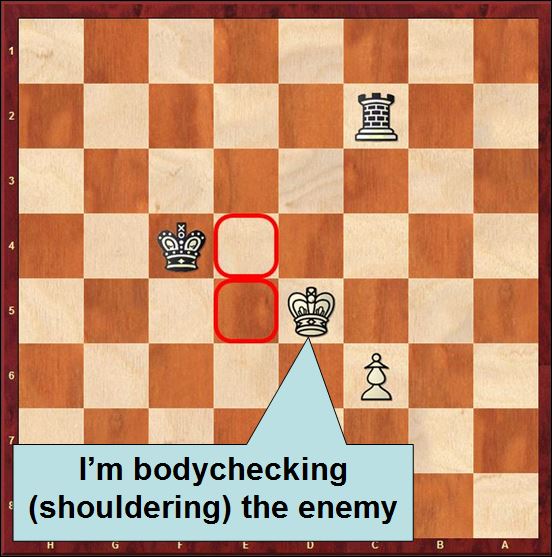
Here an example of endgame terminology one can learn: the white king is preventing the black king from going near the pawn, hence drawing the endgame, this is called 'bodycheck' or 'shouldering'.
There are 18 endgames presented by Mueller, and nine training tasks. This is the goal of this new CBM format, it's aimed to train a chess player, and through the training achieve improvement.
Before I forget, because there is so much material in every CBM, and I often fail to mention it all, mainly because I don't want the review to become too long. Every CBM comes with a booklet. If you receive the physical copy of the magazine, it includes a DVD and paper booklet, while for those of us who listen to Greta's advice, we prefer the download version, and paperless booklet, which saves the environment and the world!
In the booklet there is a section of endgame training tasks (and of course there is also a section of tactical training tasks). Here's an example:

While listening to Mueller, one can also enjoy aphorisms and quotes which come from his immense chess culture, like the following one:

"Chess is a tragedy of one tempo!"
While listening to Mueller one can gain knowledge of typical maneuvers one must know, or where a piece belong in certain endgames.
But enough with the endgames, let's pass to the section everyone worships: Tactics!
Last August I attended a work meeting, where my new boss was clearly stating that we need to teach tactics, because that is the main ingredient to create better players. One of the long time coaches, a Russian lady, mentioned she prefers to teach tactics through teaching games. CBM gives a taste of both — in multiple formats — to better teach to different players. IM and CBM editor Oliver Reeh for this issue treats a topic which is quite important: backward moves. Often such moves are not taken into consideration, because in our minds we need to go forward in order to win the game, and create attack chances.
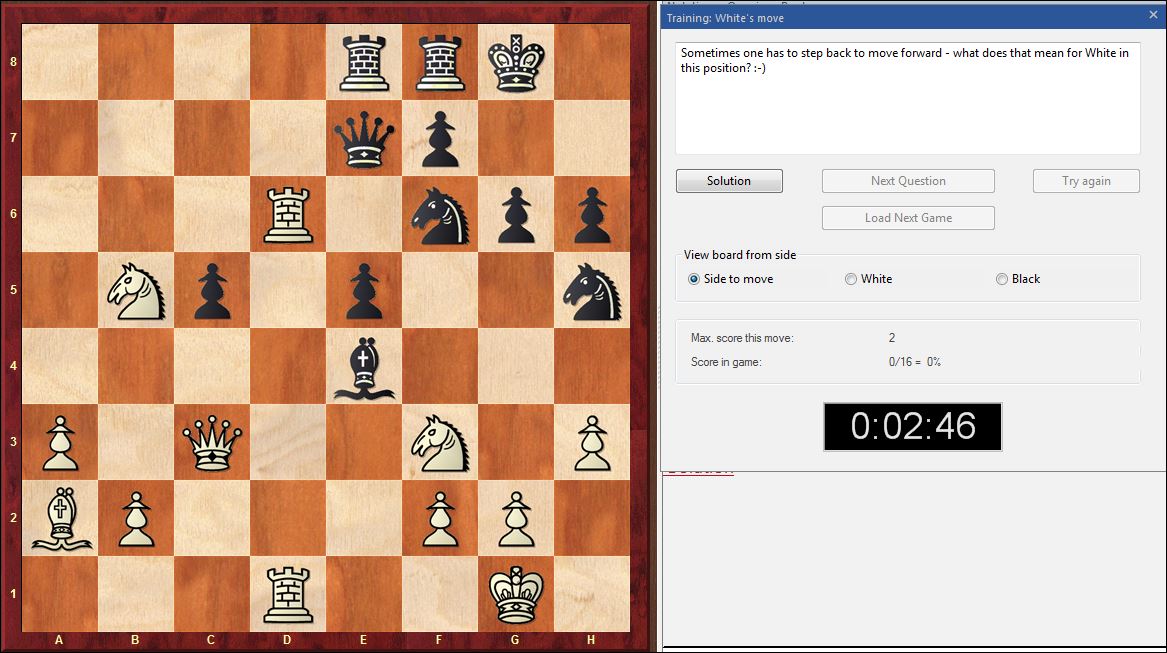
Here, through different questions, Reeh guides us to exert our tactical minds and chess understanding in different positions. But once we have answered all the questions, we still have the entire game we can watch for our pleasure, or to gain a deeper insight on how great players reached that position.
For each question there is also a timer which runs in order to simulate the real tournament conditions, where we cannot take hours to find the right move.
Here one of the games used by Reeh to teach about retreat moves:
This tactical section is made up of 14 interactive games, three videos, and the solution to nine combinations we can find in the booklet, similar to the one given as example for the endgames.
And then of course one cannot miss the most important section for the tournament player: "Ideas for your repertoire," after all if one wants to win games, or avoid losing them, survival in the opening phase is of utmost importance.
The section of opening videos is composed of three videos authored by Simon Williams, Daniel King, and Alexei Shirov respectively, on the Ruy Lopez anti-Marshall, the English, and the Sicilian Najdorf.
There are eleven theoretical articles, beginning with an article on the Scandinavian, which tries to refute the Qd6 Scandinavian, giving a very aggressive line against it: 1.e4 d5 2.exd5 ♛xd5 3.♘c3 ♛d6 4.d4 ♞f6 5.♘f3 c6 6.♘e5 ♞bd7 7.f4:
This article is crucial for Scandi players, because it was written from White's perspective, and Black needs to know what White will play...and how to neutralize it. For me this article was important, because as mentioned before my memory is not good, so I need to refresh from time to time the knowledge acquired. In this case, I went back to check an old DVD made by GM Sergei Tiviakov. In that DVD, published around a decade ago, Tiviakov acknowledged that 6.♘e5 is the most dangerous answer for black to face, and then went on to analyze it extensively from his games, giving a lot of ideas and plans. However in this article there is a fundamental game played in ICCF between 2300+ players, and one could mistakenly ask dismissively: "why is a game between FM level players so important?" Because they use engines in ICCF games, and they use them at the rhythm of three days per move, something which obviously is nowhere near to the 3-5 minutes per move used in a tournament game. At the moment in the ICCF they are using hardware which can easily rival AlphaZero, so whatever comes out of an ICCF game is definitely something to pay attention to. In my opinion just this opening article justified the price of CBM.
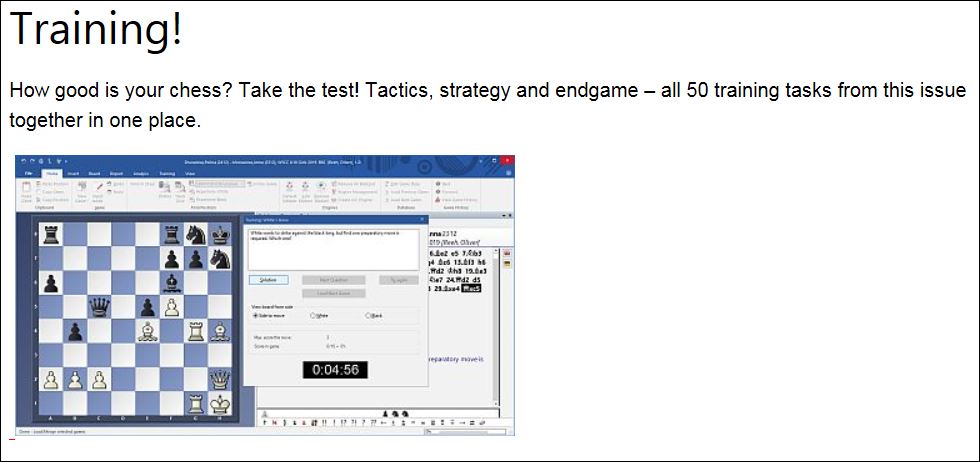
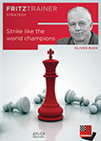 88 times, IM Oliver Reeh leads you step by step through the most brillant game conclusions of the world champions - in interactive Fritztrainer format, enabling you to enter the winning moves yourself.
88 times, IM Oliver Reeh leads you step by step through the most brillant game conclusions of the world champions - in interactive Fritztrainer format, enabling you to enter the winning moves yourself.Another section that is quite important for a regular tournament player is: Practice makes perfect — it's your move. It's a training section with 50 tasks based upon different elements of the game, which can be quite instructive. It also helps to understand chess from the past.
For example the following position comes from the game Akobian vs Ushenina, 2019:
It's White to move, but the point is that if one is already familiar with an historical precedent: Penrose vs Tal, 1960, he will know the move to play and the reasons behind. For those who don't know, the important move is White's 19th, which makes Black occupy a square, and not being able to use it as outpost or jumping point for his pieces. Here the entire game:
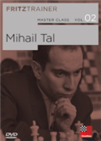 On this DVD Dorian Rogozenco, Mihail Marin, Oliver Reeh and Karsten Müller present the 8. World Chess Champion in video lessons: his openings, his understanding of chess strategy, his artful endgame play, and finally his immortal combinations.
On this DVD Dorian Rogozenco, Mihail Marin, Oliver Reeh and Karsten Müller present the 8. World Chess Champion in video lessons: his openings, his understanding of chess strategy, his artful endgame play, and finally his immortal combinations.We can see some patterns repeat themselves, and hence studying games from the past can help us connect the dots when we watch modern games.
There are two videos I always watch in every CBM: one by Williams is a kind of "guess the move", hence quite important. I wish they'd make a DVD in such format for any opening one wants to learn (with maybe 100 games one must know to play that opening!), because I believe such interactive format can help better retain the material learned, especially in the opening when one has to remember maneuvers, tactics or plans.

The game chosen by Williams is Saric vs Suleymanli from the European Club Cup, 2019, open section.
While watching the video I try learn as much as possible from Williams. For example, he mentioned Fischer played the Winawer, so I went to look at games played by Fischer in this line. This can help me to familiarize with common maneuvers and plans used in such opening. Then Williams also said he played this line few times, since I know he is an expert in the French and Dutch, I went to see some of his games and compare how such opening was interpreted in Fischer's times. After the moves: 1. e4 e6 2. d4 d5 3.♘c3 ♝b4 4. e5 c5 5. a3 ♝xc3+ 6. bxc3 ♛a5 I found the following games:
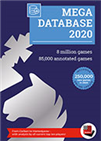 The ChessBase Mega Database 2020 is the premiere chess database with over eight million games from 1560 to 2019 in high quality. Packing more than 85,000 annotated games, Mega 2020 contains the world‘s largest collection of high-class analysed games. Train like a pro! Prepare for your opponents with ChessBase and the Mega Database 2020. Let grandmasters explain how to best handle your favorite variations, improve your repertoire and much more.
The ChessBase Mega Database 2020 is the premiere chess database with over eight million games from 1560 to 2019 in high quality. Packing more than 85,000 annotated games, Mega 2020 contains the world‘s largest collection of high-class analysed games. Train like a pro! Prepare for your opponents with ChessBase and the Mega Database 2020. Let grandmasters explain how to best handle your favorite variations, improve your repertoire and much more.And the other video I always watch is by GM Rogozenco: he annotates classic games, interesting for the general chess players who are interested in improvement via chess culture.

Rogozenco' growing collection of classical games is, in a sense, a substitute for chess books. If one adds the fact that on the latest Megabase 2020 there are more than 80 thousand annotated games, covering all the classic games printed in old books using the old descriptive notation, there's a ton of material to improve and learn.
Wrapping up — and forgive me if I couldn't cover everything — there are three top tournaments with all the games: chess.com Isle of Man, FIDE Grand Prix Hamburg, and European Team Championship. There are a total of over 1600 games in this issue.
Pro and Con
I have a 17-inch screen on my notebook. Maybe eventually I will buy a bigger one. However the part I don't understand is why to use fonts the size of 8 or less when over 60% of the screen is totally unused. Maybe the CB developer could add an option for those of us who don't have eagle eyes! [We definitely don't use 8 point font size, and you can zoom any text by clicking + or - buttons via the View tab on the Home menu — see screenshot. You might also check your Windows screen resolution setting. -Ed.]
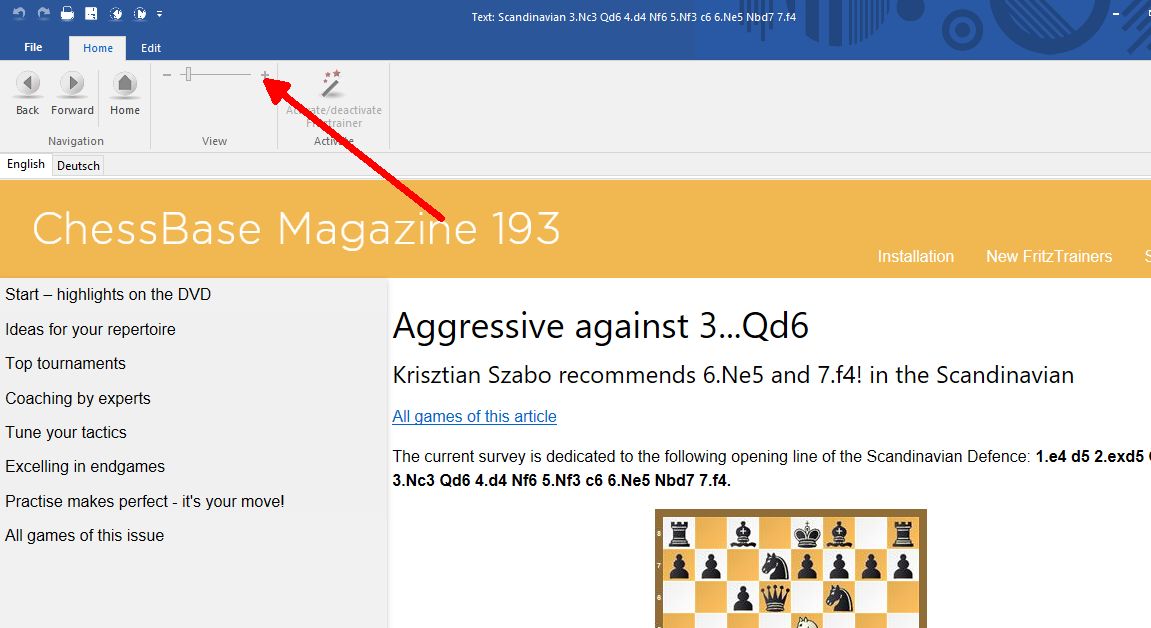
Use this slider to adjust the text size
I found interesting the Move by Move game in German, but I wouldn't mind videos in other European languages like French, Spanish or Italian.
Final thoughts
With this issue of CBM I had the chance to have my endgame skills polished by a GM, worked my tactics with an IM, studied an entire game, getting feedbacks from the famous GingerGM! And then got the latest games, checking if there were new trends in the opening, which I can use in tournament, as well as the chance to gain some new opening ideas thanks to the huge amount of theoretical articles. Having all these coaches training us month after month, and being consistent in following all the exercises proposed, is the important point I'd like to stress. Only one issue of CBM may not bring you great improvement, but after one year following such a regimen, the results will be evident. And in, say, 50 tournament games a year, the recipe for chess improvement is nearly foolproof. In this new year, definitely make a resolution to improve through ChessBase Magazine and CBM Extra.
Analyses by Caruana, Giri, Duda, Wang Hao, So, Vidit, Vitiugov, McShane and many more. Plus videos by Williams, King and Shirov. 11 opening articles with new repertoire ideas and training sessions in strategy, tactics and endgame!
Links
